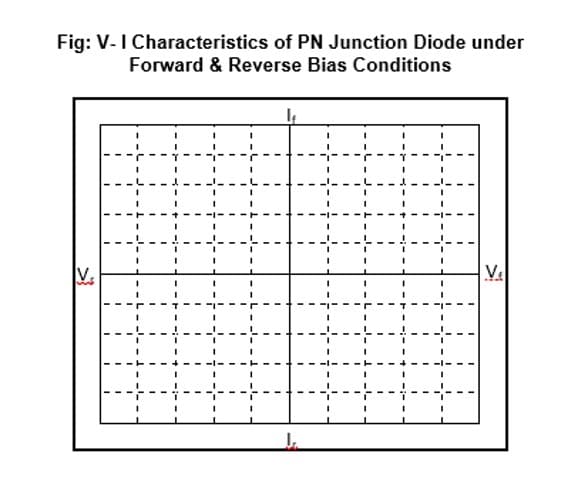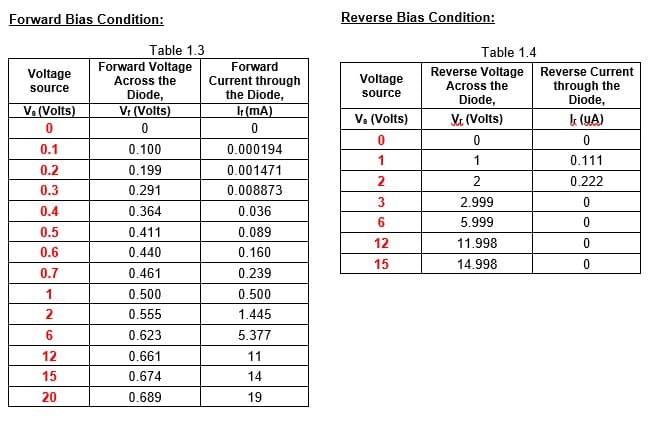Take a graph sheet and divide it into 4 equal parts. Mark origin at the center of the graph sheet. Now mark +ve X-axis as Vf, -ve X-axis as Vr, +ve Y-axis as Ifand –ve Y-axis as Ir. Mark the readings tabulated for Si forward biased condition in first Quadrant and Si reverse biased condition in third Quadrant.
Take a graph sheet and divide it into 4 equal parts. Mark origin at the center of the graph sheet. Now mark +ve X-axis as Vf, -ve X-axis as Vr, +ve Y-axis as Ifand –ve Y-axis as Ir. Mark the readings tabulated for Si forward biased condition in first Quadrant and Si reverse biased condition in third Quadrant.
Electricity for Refrigeration, Heating, and Air Conditioning (MindTap Course List)
10th Edition
ISBN:9781337399128
Author:Russell E. Smith
Publisher:Russell E. Smith
Chapter12: Electronic Control Devices
Section: Chapter Questions
Problem 3RQ: Diodes and rectifiers allow current to _________.
flow in one direction only
flow in both...
Related questions
Question
Graph:
- Take a graph sheet and divide it into 4 equal parts. Mark origin at the center of the graph sheet.
- Now mark +ve X-axis as Vf, -ve X-axis as Vr, +ve Y-axis as Ifand –ve Y-axis as Ir.
- Mark the readings tabulated for Si forward biased condition in first Quadrant and Si reverse biased condition in third Quadrant.

Transcribed Image Text:Fig: V-I Characteristics of PN Junction Diode under
Forward & Reverse Bias Conditions
V.
Ve

Transcribed Image Text:Forward Bias Condition:
Reverse Bias Condition:
Table 1.3
Forward Voltage
Across the
Diode,
Vr (Volts)
Table 1.4
Forward
Reverse Voltage Reverse Current
through the
Diode,
Voltage
Current through
the Diode,
G(mA)
Voltage
source
Across the
source
Diode,
V3 (Volts)
Vs (Volts)
Ve (Volts)
k (YA)
0.1
0.100
0.000194
1
1
0.111
0.2
0.199
0.001471
2
0.222
0.3
0.291
0.008873
2.999
0.4
0.364
0.036
6.
5.999
0.5
0.411
0.089
12
11.998
0.6
0.440
0.160
15
14.998
0.7
0.461
0.239
1
0.500
0.500
2
0.555
1.445
6.
0.623
5.377
12
0.661
11
15
0.674
14
20
0.689
19
Expert Solution
This question has been solved!
Explore an expertly crafted, step-by-step solution for a thorough understanding of key concepts.
Step by step
Solved in 3 steps with 2 images

Knowledge Booster
Learn more about
Need a deep-dive on the concept behind this application? Look no further. Learn more about this topic, electrical-engineering and related others by exploring similar questions and additional content below.Recommended textbooks for you

Electricity for Refrigeration, Heating, and Air C…
Mechanical Engineering
ISBN:
9781337399128
Author:
Russell E. Smith
Publisher:
Cengage Learning

Delmar's Standard Textbook Of Electricity
Electrical Engineering
ISBN:
9781337900348
Author:
Stephen L. Herman
Publisher:
Cengage Learning

EBK ELECTRICAL WIRING RESIDENTIAL
Electrical Engineering
ISBN:
9781337516549
Author:
Simmons
Publisher:
CENGAGE LEARNING - CONSIGNMENT

Electricity for Refrigeration, Heating, and Air C…
Mechanical Engineering
ISBN:
9781337399128
Author:
Russell E. Smith
Publisher:
Cengage Learning

Delmar's Standard Textbook Of Electricity
Electrical Engineering
ISBN:
9781337900348
Author:
Stephen L. Herman
Publisher:
Cengage Learning

EBK ELECTRICAL WIRING RESIDENTIAL
Electrical Engineering
ISBN:
9781337516549
Author:
Simmons
Publisher:
CENGAGE LEARNING - CONSIGNMENT